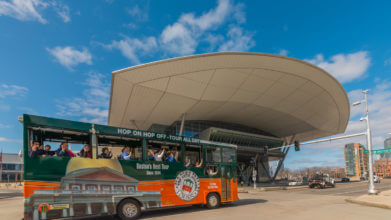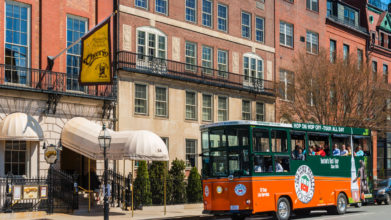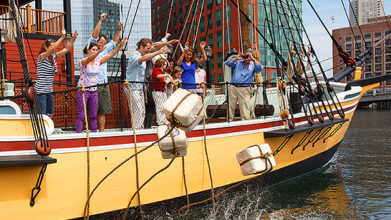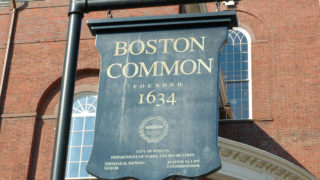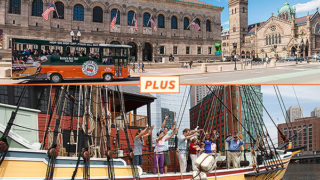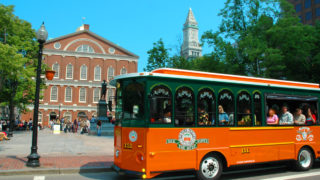Boston Massacre Site
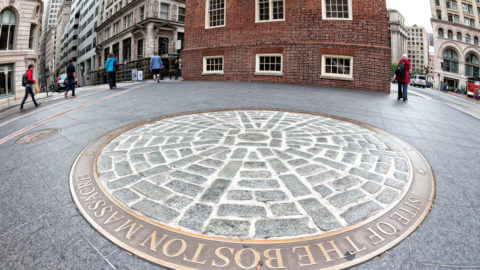
On March 5, 1770, the tension from the British military occupation of Boston escalated into the event now referred to as the Boston Massacre. There was heavy military presence in downtown Boston in order to maintain control over civilians and to enforce the Townshend Act. Various brawls between soldiers and civilians had taken place; but the evening of March 5th was the first to result in civilian deaths. Today the site of the massacre is marked by a cobblestone ring on the traffic island at the intersection of Devonshire and State Streets.
The Boston Massacre occurred on the evening of March 5, 1770 and was one of the pivotal events leading up to the American Revolution. A squad of British soldiers came to the assistance of a single sentry who was being taunted by a crowd of people hurling insults, snowballs, rocks and other objects. An object struck one of the British Regulars, Private Hugh Montgomery, who then discharged his musket. Without orders, other soldiers fired their weapons into the crowd. Three people were killed instantly and two others eventually died because of their injuries. The dead, including African-American Crispus Attucks, as well the six wounded individuals are considered the first casualties of the American Revolution. The event was not named the Boston Massacre until several decades later. It was initially called the “Incident on King Street,” the “Bloody Massacre on King Street” and the “State Street Massacre.”
History of the Boston Massacre
Tensions had risen in Boston between local citizens and the British troops who were stationed in the city beginning in 1768 to safeguard customs officials and enforce the Townshend Acts. The tension came to a head that fateful evening. Legend holds that a small group led by apprentice Edward Garrick was harassing British officer John Goldfinch for not paying his bill to Garrick’s boss. Garrick was unaware that the bill was paid the day before the incident. After witnessing the altercation, Customs House sentry Private Hugh White came to the officer’s defense. During their argument, White struck Garrick with his musket, which further escalated the situation. A larger crowd grew as someone rang church bells, an action generally taken to signal a fire.
As the crowd around White grew larger and more boisterous, Captain Thomas Preston dispatched a squad of soldiers to relieve White and disperse the crowd. Many protestors dared the soldiers to fire their weapons. Local innkeeper Richard Palmes asked Preston if the soldiers’ weapons were loaded. The officer said that they were, but would only be fired under his orders. Henry Knox, who would later be a general in the Continental Army, warned Preston that there would be dire consequences if his men fired. After Montgomery fired his musket, more objects were thrown at the soldiers. Several of the soldiers then fired their weapons without orders.
The Aftermath
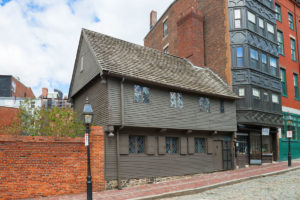 To disperse the angry crowd, Lieutenant Governor William Hutchinson said that an investigation would be conducted. Hutchinson arrested some of those involved and also ordered the removal of soldiers from the city to barracks on Castle Island.
To disperse the angry crowd, Lieutenant Governor William Hutchinson said that an investigation would be conducted. Hutchinson arrested some of those involved and also ordered the removal of soldiers from the city to barracks on Castle Island.
Captain Preston and eight soldiers stood trial and were represented by future president John Adams. They all pleaded not guilty. While Preston and six others were found not guilty, two soldiers were found guilty of manslaughter. It was the first time that reasonable doubt was used as a defense. Because they could read, the soldiers convicted avoided the death penalty by pleading “Benefit of Clergy.” They had the letter “M” branded on their thumbs instead.
Paul Revere created the famous engraving “The Bloody Massacre Perpetrated in King Street,” which became highly effective in influencing the cause of independence.
Memorials to the Victims
Site Marker
The Boston Massacre Site Marker is located in the median at the intersection of State and Congress streets. The marker is a circle of gray pavers with a star in the center.
Victims’ Graves
The victims of the massacre are entombed in a prominent grave situated in the Granary Burying Ground.
Spirit of Revolution
A 25-foot-tall monument depicting the Spirit of Revolution was erected in Boston Common in 1887. The figure has a broken chain in one hand and an American flag in the other. The crown of the British monarchy is being trampled under the figure’s foot. It is the work of Adolph Kraus and Carl Fehmer.
Visitor Information
Admission and Annual Event
The Boston Massacre Site Marker can be observed every day of the year free of charge. Be careful of traffic when crossing the street to observe the marker up close. The massacre is reenacted on the anniversary of the event, which was a state holiday from 1771 until 1783.
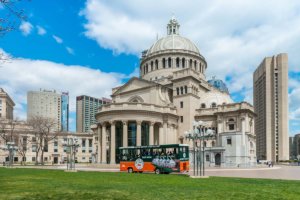 Getting to the Site
Getting to the Site
The best way to see the historic site of the Boston Massacre as well as everything else Boston has to offer is aboard the Old Town Trolley. Hop off at Stop #5 to explore the site and surrounding area. When you’re ready to continue to ride, hop back aboard the next trolley. For those taking public transportation, the nearest T stop is STATE on the Blue and Orange Lines. The station is located in the basement of the Old State House.
Things to Do Nearby
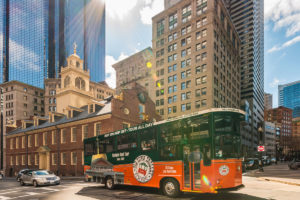 Old State House
Old State House
Adjacent to the Boston Massacre Site Marker, the Old State House was built in 1713. It is the oldest extant public building in the city. This National Historic Landmark was the scene of numerous key events in Colonial history.
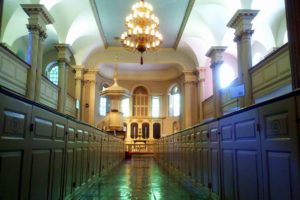 King’s Chapel
King’s Chapel
Founded in 1686, King’s Chapel was the first Anglican house of worship in the Massachusetts Bay Colony. Boasting an elegant interior, the stone Georgian-style edifice was built around the original wooden structure. During construction, the wood was removed through the new windows. The church was designed by Peter Harrison, America’s first architect.
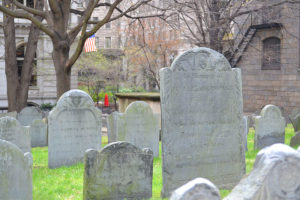 King’s Chapel Burying Ground
King’s Chapel Burying Ground
King’s Chapel Burying Ground is the oldest cemetery in Boston. Established in 1630, it contains the graves of John Winthrop, the first governor of the Massachusetts Bay Colony, and Mary Chilton, who is believed to be the first woman to step off the Mayflower. The grave of Elizabeth Pain is said to have inspired the character Hester Prynne in Nathaniel Hawthorne’s The Scarlett Letter.
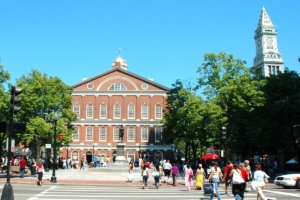 Faneuil Hall Marketplace
Faneuil Hall Marketplace
Faneuil Hall Marketplace is a collection of shops and eateries occupying the setting of this famous meeting house. Built in 1743, the site was the backdrop for several speeches by prominent patriots like Samuel Adams and others who urged independence from Great Britain. Famous local architect Charles Bulfinch played a major role in the current design.

